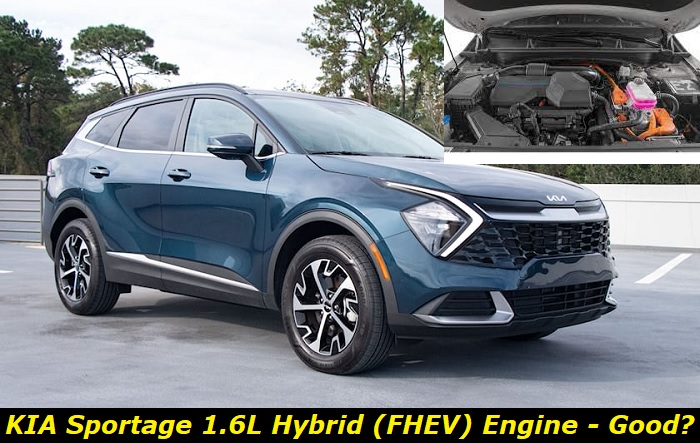KIA Sportage keeps holding its strong position in the market of pretty affordable and practical compact SUVs. But what if you don't want the most affordable version powered by an old-fashioned gasoline engine that we've already reviewed before on the Cararac.com blog? The Sportage has something to offer - there are two hybrid powerplants to choose from.
Today, we'll tell you about the 1.6L Full Hybrid (FHEV) engine (G4FT/G4FU) in the new KIA Sportage and will cover all common questions that people ask about this powerplant. Please bear in mind that we are not talking about the more expensive plug-in hybrid version. That one will most likely be covered in one of our next articles.

Key facts and my opinion about the engine
- Production years: 2020-now
- Average lifespan of G4FT/G4FU: 130,000-150,000 miles
- Fuel supply type: direct injection
- Power range: 180 hp
- Fuel efficiency: excellent
- Engine block material: aluminum
- Engine reliability score: low
- The most common problems: timing chain issues, catalytic converter too close to the engine block, no lifters.
What should you know about the 1.6L Hybrid Sportage engine (FHEV)?
So, this is not a plug-in hybrid and this version can't go all-electric. The powerplant always works as a pair of the gasoline engine which is a 1.6L Smartstream Turbo engine that we've already reviewed in other KIA and Hyundai models and the electric motor. Also, the system has a high-voltage battery, just like in EVs but of a significantly smaller size.
The FHEV version doesn't cost a lot in comparison with some competitors on the market. You can get the cheapest Sportage Hybrid for under $29,000. There are three trims available and the most expensive will cost about $10,000 more with the same powerplant under the hood and absolutely the same performance. Well, we believe KIA overestimates its tech offers for higher trims a little bit.
So, here's what you may want to know about the engine itself:
- the heart of the powerplant is the 1.6L Smartstream Turbo engine codenamed G4FT or G4FU, the engine is pretty new but very popular;
- the electric motor offers 44.7 kW of power and this is a permanent magnet electric motor which is a single electric unit in the vehicle;
- the battery is a lithium-polymer 1.49 kWh battery pack that can be charged and discharged over 3000 times;
- the overall power is estimated at 227 horsepower and the torque is 258 lb-ft which is not that bad for a compact SUV;
- the engine is pretty fresh, it has been here since 2020, it offers the new CVVD technology for valve control, direct injection, chain-drive timing, etc.;
- the powerplant comes equipped with a 6-speed automatic transmission which is really good for durable and problem-free use;
- when it comes to gas mileage, the 1.6 FHEV Sportage may offer 42 MPG in the city and about 44 MPG on highways.
This hybrid powerplant is like a bridge between plug-in hybrids and pure gasoline-powered vehicles. You get great gas mileage that you will not get in any gas-powered car and also you don't need to recharge your vehicle and think about possible bankruptcy if you suddenly need to replace the battery pack.
We also like how the car goes. It accelerates quickly and you won't feel the lack of power. The gasoline engine is always ready to rev up and give you enough power for any style of driving you want to use. The transmission feels a little jerky sometimes, but this is what you pay for durability and cheap maintenance of the traditional automatic transmission.
How long will the 1.6L Hybrid in your Sportage last?
When it comes to full-hybrid vehicles that are not rechargeable, you can say they are more durable and better to own than EVs or PHEVs. Yes, they are a little more expensive to drive because of certain gas consumption and no all-electric mode. But you still get great gas mileage and more durable units.
For example, the G4FT/G4FU engine in the Sportage Hybrid can last about 140,000 miles until it needs its first serious repair or even replacement. Also, the transmission is durable and can go up to 150,000 miles without repairs if the transmission fluid is changed regularly. The electric motor can live twice as long as the gasoline one, so it won't cause any problems.
But the battery pack is going to be the unit that may spoil your mood a little. While in some cars, it will be OK for the whole life of the SUV, in others it may fail at 100,000 miles or even earlier. The good thing is that replacing the 1.49-kWh battery pack is not as expensive as replacing the average EV or PHEV battery pack which may be twenty times more expensive.
So, we would say that the Sportage 1.6L HEV powerplant can go about 140,000 with one serious repair which is the battery replacement. Also, in the middle of that range, you will need to replace the timing belt and make sure some units of your engine are in good condition. Let's move on to see what exactly you will have to check.
Common problems with the 1.6L HEV engine in the new Sportage
To understand what you should look at when maintaining and repairing your Sportage Hybrid, you should know some of the most common problems that may happen with this engine. We still don't know how the valve-control technology is going to work here (CVVD). But we won't outline it as one of the problems because it may eventually be OK. But you should surely pay some attention to it once your hybrid Sportage hits the 50K-mile mark.
Here are some problems you are likely to experience with this vehicle:
1. Timing chain issues
Unfortunately, nearly all recent Hyundai-KIA engines have problems with timing chains. They are too thin and stretch at 80-100 thousand miles. Once you hear the engine rattling, make sure you don't drive your vehicle a lot until you have the issue fixed. The stretched chain may break or just jump and this will destroy the valve system once one of the valves will hit a piston.
If the timing chain breaks, chances are that the engine is not good to repair. It may be cheaper to buy a new one from a KIA dealership which is still extremely expensive. So, keep an eye on this!
2. Direct injection issues
Yes, this type of injection is still the most efficient for gas engines, but it comes with a hidden flaw. Your intake valves will gradually cover with carbon buildup because the fuel doesn't go through valves and is injected directly into the combustion chamber instead. This is a cool way to get more power from the engine and avoid higher consumption. But this system has a traditional problem with a pretty expensive solution - valve cleaning at least every 30K miles.
3. No hydraulic lifters and bad maintenance
KIA says a lot about the maintenance of this engine and you should pay attention to all the recommendations. Only proper maintenance in the dealership (which is traditionally super expensive) will allow you to drive your Sportage Hybrid for many years and be OK.
One of the regular procedures for this engine is valve adjustment which is ridiculous for a modern powerplant. Valve adjustment costs a lot! There are no hydraulic lifters to help your valves adjust automatically.
4. Battery pack problems
The first problems with the 1.49-kWh battery pack will be there at 50,000 miles. The vehicle may start burning more gasoline because the battery pack has already lost some of its capacity. After 80,000 miles, the situation may get even worse and you will basically drive a gas-powered Sportage instead of a hybrid. Battery pack replacement will help but don't think it's a cheap repair.
What can you do to prolong the life of this powerplant?
Proper regular maintenance is your key to success. We don't like prices in KIA dealerships but we still recommend servicing your vehicle there because there aren't many repair shops that can properly repair and maintain your new hybrid vehicle.
Also, avoid aggressive driving in your Sportage HEV. Although this powerplant feels sporty and very aggressive, any kind of abuse will surely kill the battery and the 1.6L gas engine. Calm driving will provide you with durability and also cheap driving costs thanks to optimal fuel consumption.
We recommend checking up on the battery health after the vehicle reaches 50,000 miles and every 10K miles after that. Once the battery is not efficient anymore, you may need to replace it. Also, the engine needs some attention. Replacing the timing chain at 80,000 miles seems like a good idea to avoid the disastrous consequences of its stretching.
Other than that, your new Sportage Hybrid FHEV is just a good hybrid SUV that doesn't need a lot of attention for most units and parts. Of course, some TLC will obviously make it go more miles and years without demanding costly repairs.
About the authors
The CarAraC research team is composed of seasoned auto mechanics and automotive industry professionals, including individuals with advanced degrees and certifications in their field. Our team members boast prestigious credentials, reflecting their extensive knowledge and skills. These qualifications include: IMI: Institute of the Motor Industry, ASE-Certified Master Automobile Technicians; Coventry University, Graduate of MA in Automotive Journalism; Politecnico di Torino, Italy, MS Automotive Engineering; Ss. Cyril and Methodius University in Skopje, Mechanical University in Skopje; TOC Automotive College; DHA Suffa University, Department of Mechanical Engineering






Add comment